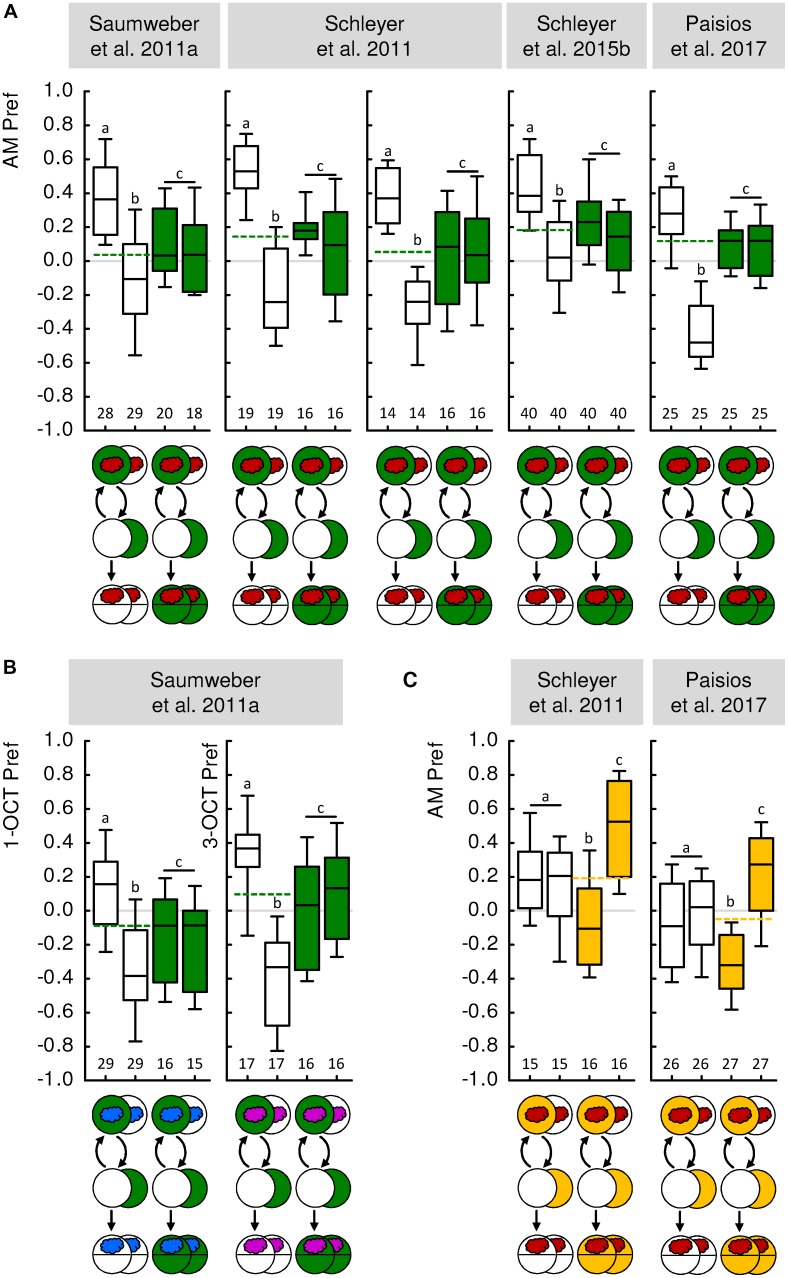FIGURE 1.
Paired and unpaired memory in larval Drosophila. (A) In five independent experiments from four different previously published studies, paired and unpaired memory was demonstrated using n-amyl acetate as the odor (AM, red cloud) and fructose as the reward (green-filled circles). In a Petri-dish assay, odor and reward were presented paired such that the odor was presented while the animals were on a reward-containing Petri dish; the animals were then transferred to an empty Petri dish without odor or reward (white-filled circle). In an independent group of animals, odor and reward were presented unpaired, in consecutive trials. When tested for their preference for the odor (AM Pref), the larvae preferred the odor more after paired than after unpaired training (white-filled box plots). When tested on a reward-containing Petri dish, however, the larvae displayed an intermediate level of odor preference that was the same regardless of the training regimen (green-filled box plots). This can therefore serve as a baseline for odor preference in animals that have established, but do not behaviorally express, associative odor memory (stippled line). Such a procedure reveals that memory through reward-paired training increases, whereas memory through reward-unpaired training decreases odor preference relative to this baseline. (B) Same as (A), but using either 1-octanol (1-OCT, blue cloud) or 3-octanol (3-OCT, purple cloud) as odors. In two independent, previously published experiments, paired and unpaired memory was demonstrated using n-amyl acetate as the odor (AM, red cloud) and quinine as punishment (yellow-filled circles). Only when tested for their odor preference on a punishment-containing Petri dish did the larvae avoid the odor more after paired than after unpaired training (yellow-filled box plots). When tested in the absence of punishment, the larvae displayed an intermediate level of odor preference that was the same regardless of the training regimen (white-filled box plots, yellow stippled line). Thus, punishment-paired training decreases, whereas punishment-unpaired training increases odor preference relative to the baseline odor preference shown in the absence of the punishment. Data were taken from the publications indicated above each experiment. For more details on experimental parameters and the methods used, see Table 1 as well as the Methods sections of the indicated papers. Box plots indicate the median as the middle line and the 25/75% and 10/90% quantiles as box boundaries and whiskers, respectively. Sample sizes are displayed below each box-plot. In all cases, the preference values were statistically indistinguishable between the training regimens when animals were tested under baseline conditions [Mann–Whitney U-tests (MW), P > 0.05 corrected according to Bonferroni–Holm within each experiment], indicated by a common letter and a vertical bar above the box plots. The stippled line indicates the median of the pooled preference data under baseline conditions. The preferences after paired and after unpaired training differed from each other, as well as from baseline (MW, P < 0.05 corrected according to Bonferroni–Holm within each experiment), as indicated by different letters above the box plots. For detailed statistical results see Supplementary Table S1.

